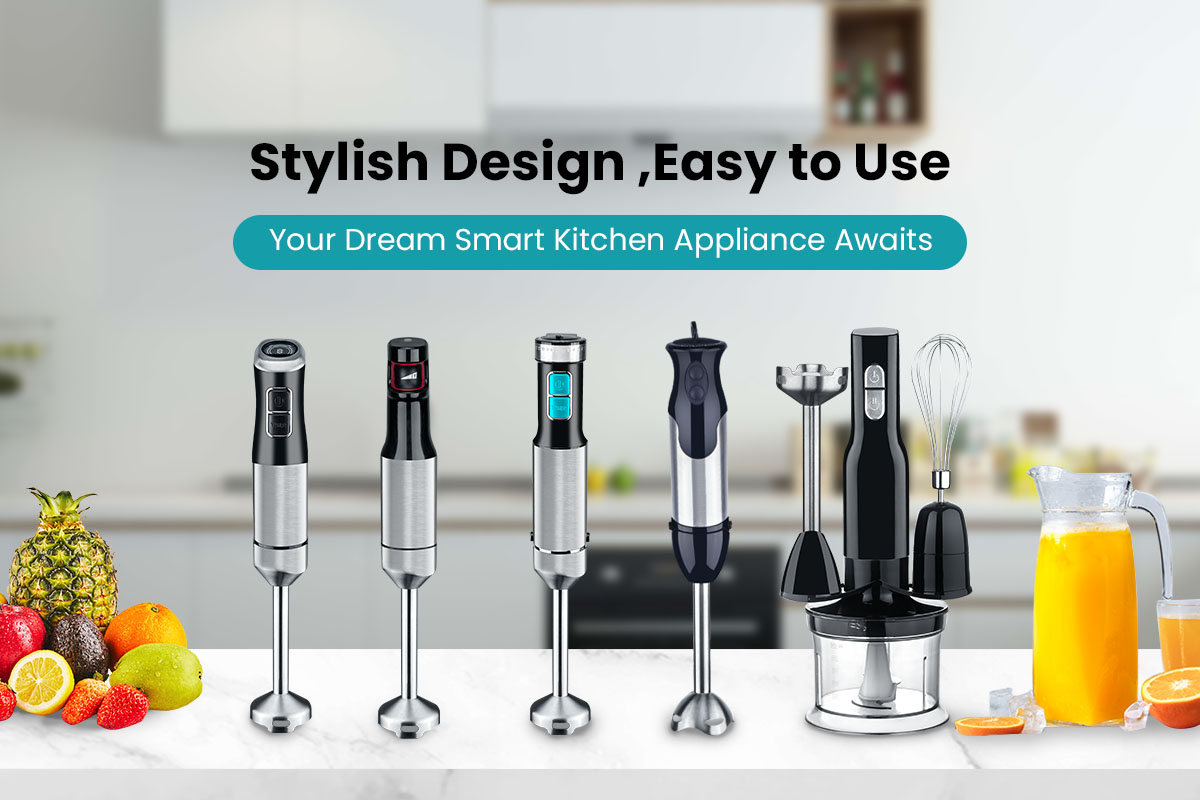Can A Hand Mixer Replace An Immersion Blender
At first glance, hand mixers and immersion blenders may look similar — both are handheld kitchen tools powered by electric motors. However, their functions, designs, and performance differ significantly. So, can a hand mixer really replace an immersion blender?
The short answer is: sometimes, but not always.
This guide breaks down their key differences, when substitution works, and when you absolutely need the real thing — with insights from KANGJIA Electrical Appliances Co., Ltd., a professional manufacturer of high-quality Hand Blenders and kitchen appliances.
1. Understanding the Two Appliances
Before deciding if one can replace the other, it’s important to understand what each tool is designed to do.
Immersion Blender (hand blender)
A stick-shaped blending tool with rotating blades at the base.
Designed for pureeing, blending, emulsifying, and frothing directly in bowls or pots.
Ideal for soups, sauces, smoothies, and baby food.
Example: KANGJIA’s hand blender series uses stainless steel shafts and multi-blade designs to achieve smooth, consistent textures.
Hand Mixer
Comes with two beaters or dough hooks that spin in a bowl.
Designed for mixing, whipping, or beating ingredients like eggs, cream, or batter.
Ideal for baking tasks rather than liquid blending.
The hand mixer incorporates air into mixtures, while an immersion blender breaks down solids — that’s the key difference.
2. When a Hand Mixer Can Replace an Immersion Blender
There are limited situations where a hand mixer can substitute for an immersion blender — mostly when you’re mixing soft or uniform ingredients.
| Task | Can a Hand Mixer Replace It? | Notes |
|---|---|---|
| Whipping cream or egg whites | ✅ Yes | A hand mixer is actually better for aeration |
| Mixing pancake or cake batter | ✅ Yes | Hand mixer gives even results |
| Combining sauces or dressings | ⚠️ Partial | Can mix but won’t fully emulsify |
| Pureeing soup or baby food | ❌ No | Mixer can’t break down solids |
| Making smoothies or shakes | ❌ No | Needs blades to crush fruit or ice |
| Blending hot liquids | ❌ Unsafe | Mixer splashes — use immersion blender instead |
In short: a hand mixer can mix and whip, but it cannot puree or blend solids.
3. Why They’re Not Fully Interchangeable
The difference lies in mechanics:
| Feature | Immersion Blender | Hand Mixer |
|---|---|---|
| Attachment Type | Sharp blades | Beaters or whisks |
| Primary Function | Blend and puree | Whip and mix |
| Texture Outcome | Smooth, creamy | Light and airy |
| Best For | Soups, sauces, smoothies | Cakes, cream, dough |
| Handling Liquids | Excellent | Poor (causes splatter) |
| Handling Solids | Excellent | Ineffective |
Example:
If you’re making tomato soup, an immersion blender can create a silky, smooth texture right in the pot. A hand mixer, on the other hand, will splash and leave chunks, since it’s not designed to cut solids.
That’s why professionals prefer KANGJIA immersion blenders with stainless steel blades for smooth consistency and safe hot blending.
4. When You Can Use a Hand Mixer Instead
If you don’t have an immersion blender on hand, you can still use a hand mixer for some quick kitchen fixes — as long as you adjust your expectations.
Suitable Uses
Mixing pancake batter, mashed potatoes, or sauces.
Whipping cream, frosting, or egg whites.
Light blending of soft ingredients (like cooked pumpkin or ripe bananas).
Not Recommended For
Blending soups, fruits, or vegetables — the texture will remain lumpy.
Crushing nuts, ice, or fibrous ingredients.
Making smoothies, purees, or dips that require uniform texture.
For smooth, restaurant-quality results, a hand blender’s blade-driven system is irreplaceable.
5. Safety and Practicality Considerations
| Factor | Hand Mixer | Immersion Blender |
|---|---|---|
| Ease of Cleaning | Easier (removable beaters) | Slightly more work (blades) |
| Safety for Hot Food | ❌ Not safe for soups | ✅ Designed for hot use |
| Speed Control | Great for whipping | Great for blending precision |
| Noise Level | Slightly louder | Quieter on high-end models |
| Storage Space | Compact | More compact and versatile |
Many KANGJIA immersion blenders come with detachable shafts and accessories, making them just as easy to clean and store as a hand mixer.
6. The Best Solution — Have Both
If you cook and bake regularly, the ideal setup is to own both tools:
Use the immersion blender for liquid and smooth blending.
Use the hand mixer for baking, whipping, and mixing.
Bonus: Some Hybrid Models
Some brands (including KANGJIA) offer 2-in-1 hand blenders with both blending blades and whisk attachments, letting you switch between whipping and blending functions easily.
This combination saves space while giving you the best of both worlds.
✅ Summary
| Function | Hand Mixer | Immersion Blender |
|---|---|---|
| Whipping Cream / Eggs | ✅ Excellent | ⚠️ Limited |
| Mixing Batter | ✅ Good | ⚠️ Over-blends |
| Pureeing Soup | ❌ Poor | ✅ Excellent |
| Making Smoothies | ❌ No | ✅ Yes |
| Emulsifying Sauces | ⚠️ Moderate | ✅ Strong |
| Cleaning Ease | ✅ Easy | ✅ Easy (detachable models) |
Final Thoughts
A hand mixer can replace an immersion blender only for light mixing and whipping tasks, but not for blending or pureeing. Each tool has its own purpose:
The hand mixer adds air and texture.
The immersion blender creates smooth, consistent blends.
If you need versatility — from soups to whipped cream — a high-quality immersion blender set with multiple attachments, like those from KANGJIA Electrical Appliances Co., Ltd., is your best investment.
In short: hand mixers mix, immersion blenders blend. Use each where it shines, and your kitchen will handle every recipe effortlessly.





